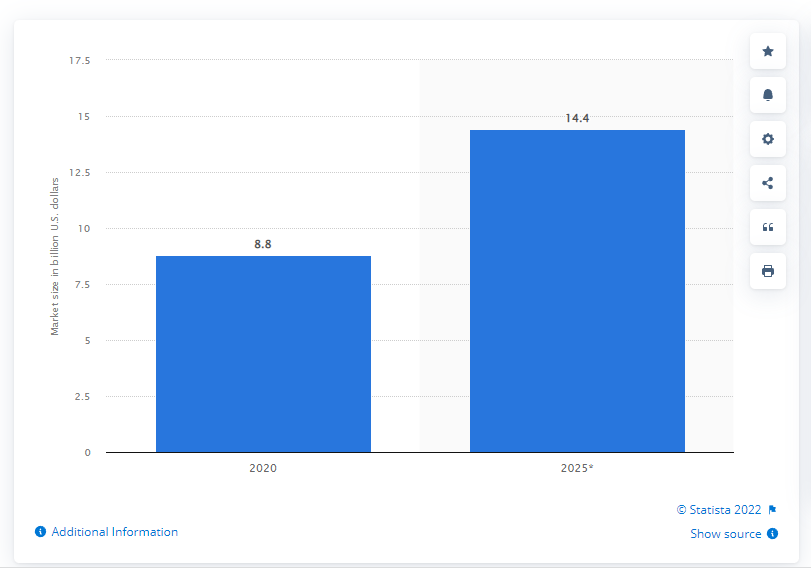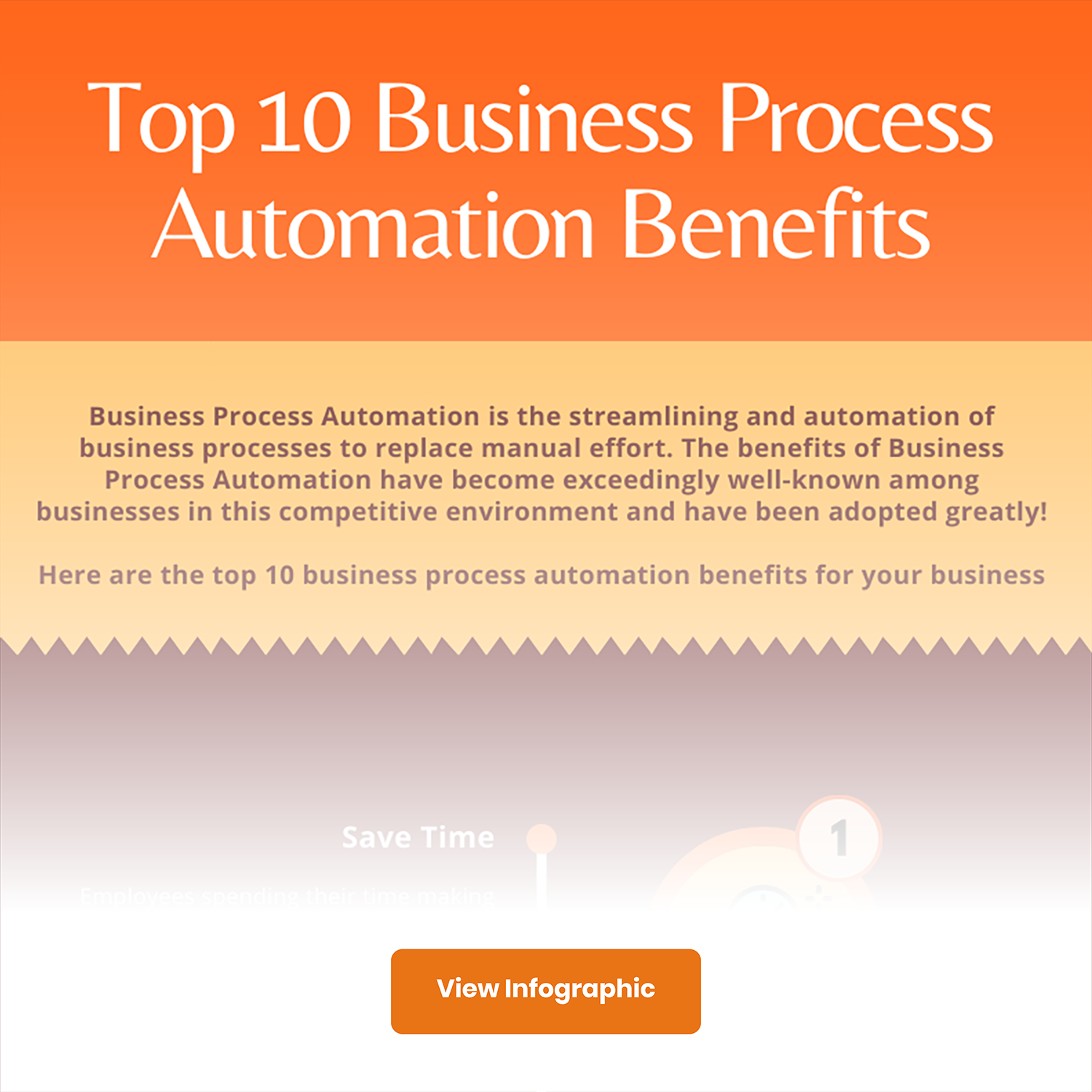
Business process automation is rapidly becoming a strategic enabler of market control. Technological innovations and the growth of cloud computing facilitated the transformation of business processes from ‘re-engineering’ to ‘automation’. Today, the aim is to maximize automation rather than re-engineer it. But why? What are the real business process automation benefits? Let’s learn about the top 10 business process automation benefits.

Also Read: Business process management – The what, why, and how
Top 10 Business Process Automation Benefits
List below are the top benefits of business process automation benefits.
1. Save Time
Manual activities can take time. They must be done linearly by humans who are susceptible to error and are unable to constantly reach the highest standards.
Business process automation reduces the number of tasks you and your employees do manually. Automation frees your time to work on other tasks that add real value to your company, resulting in you and your employees feeling more productive and effective.
Imagine an employee manually feeding data from insurance claim files into the claims system. Now compare that to the same task done by the customer himself using an online portal !!
Also Explore: Unlock the Potential of Streamlined Insurance Claim Processes with Quixy
2. Improve Transparency
One of the biggest advantages of business process automation is the transparency it brings to the system. Every process involves a series of tasks that need to be executed. With automation, you get clear logs for every task that show what was done, who did it, and when it was done.
3. Improve Quality & Consistency
Quality: Automation guarantees that any operation is carried out in the same way, resulting in high quality and consistent performance.
Consistency: If your customer service follow-up process has been automated, your customers can expect a consistent experience while working with your service team.
Consistency of automated processes means that you can rely on (a) your business processes to function, and (b) you can give your customers efficient processes while retaining a competitive edge.
This assurance of quality and consistency, combined with time savings and productivity, ensures that you can start delivering higher quality services and products.

4. Improve Operational Efficiency
Efficiency, by definition, describes the extent to which time, effort, and cost is effectively applied for the intended task or purpose.
Business process automation decreases the amount it takes to perform a task, the effort required to execute it, and the cost of successfully completing it.
Automation not only ensures that processes operate smoothly and efficiently but that errors are reduced and also that the best practices are continuously being leveraged.

5. Reduce Turnaround Times
Workflow automation enables companies to define and streamline their business processes., eliminate redundant tasks and realign process measures to improve the flow of information across the various departments.
This process improvement distills the operating efficiency and reduces turnaround times for the stakeholders.
6. Reduce Costs
This is one of the key business process automation benefits.
Manual tasks, given that they are done one-on-one and at a slower rate than automated task, would cost more. Business process automation allows you to do much more while using fewer resources.
Learn More: Calculate how much you can save with process automation.
7. Make Better Forecasts and Projections
In an earlier, less technologically-enriched period, predictions had to depend mostly on guesswork. There was simply not enough workforce and tools to manage processes and their outcomes. With proper business process automation, you have the tools to monitor the processes and their outcome. The data that becomes available from this monitoring can then be used to make intelligent forecasts and predictions.

8. Increase Accountability
With so many different systems in place, it may be difficult to know exactly what’s going on at every stage of the business process.
Automation eliminates human error by providing a digital trail to various aspects of your business. It provides a simple way to access important process metrics that you have chosen to automate (sales, customer service, finance, billing). It offers a visual and structured environment where all employees have a centralized view, offering greater transparency for everyone’s actions.
Impact Stories: Application Development Time Reduced by 60% for Compass Group
9. Improve Customer Satisfaction
Business process automation does not only offer advantages to your side of the equation; it can also make your customers happy. Your customers will receive reliable and consistent products and services and improve the efficiency of your business.
If we take an example of an eCommerce site, your customers can key in their tracking number into your system to know exactly where their orders are in the process without having to call customer service or send an email. This improves overall customer satisfaction.

10. Improve Employee Morale
The biggest mistake that organizations make is increasing their employees’ work shifts to compensate for their shortcomings. A lot of employees today spend most of their time doing manual labor, repetitive tasks that don’t bring much value to the company.
Automation of manual tasks can free up employees’ time for high-value activities. Giving your employees space and freedom can help activate their creative and innovative skills. This will improve their morale, which can do wonders for your company.
Also Read: 3 must-have Digital Transformation tools for Business Continuity
Concrete Examples of Business Process Automation Benefits
Here’s a breakdown of how automation streamlines tasks, reduces errors, and improves communication in two specific business processes:
1. Accounts Payable Processing
- Manual Process
- Invoices are received via mail or email, requiring manual data entry into the accounting system.
- Employees might need to chase approvals from managers or verify purchase orders before processing payments.
- Manual checks are printed, signed, and mailed, leading to delays and potential loss.
- Automated Process
- Invoices are scanned or uploaded electronically, triggering automatic data extraction and verification against purchase orders.
- Approval workflows are established within the system, routing invoices to designated managers for electronic sign-off.
- Payments are automatically initiated via electronic funds transfer (EFT) on approval, ensuring faster payments and eliminating the risk of lost checks.
Benefits
- Streamlined Tasks: Automation eliminates manual data entry, chasing approvals, and printing/mailing checks, saving significant time and resources.
- Reduced Errors: Automatic data extraction and verification minimize the risk of human error in data entry.
- Improved Communication: Electronic workflows and notifications ensure clear communication throughout the approval process.
2. Marketing Campaign Management
- Manual Process
- Marketing teams manage campaigns using spreadsheets or email, making it difficult to track campaign performance and engagement metrics across different channels.
- Manually creating and sending personalized email campaigns can be time-consuming and prone to errors.
- Reporting relies on manual data compilation, making it difficult to measure campaign effectiveness.
- Automated Process
- Marketing automation platforms centralize campaign management across channels like email, social media, and web marketing.
- Automated workflows can be set up to trigger personalized email sequences based on customer behavior or demographics.
- Real-time dashboards provide insights into campaign performance, allowing for data-driven optimization and A/B testing.
Benefits
- Streamlined Tasks: Automation simplifies campaign creation, scheduling, and content delivery across various channels.
- Reduced Errors: Automated processes eliminate manual tasks like email list management and personalized message creation, minimizing human error.
- Improved Communication: Automation ensures consistent messaging across channels and triggers timely communication based on customer interactions.
3. Human Resources Onboarding
- Manual Process: New hires navigate a paper-based onboarding process, filling out forms, attending in-person training sessions, and waiting for manual approval for system access. This can be time-consuming for both HR and the new employee.
- Automated Process: An HR automation platform streamlines onboarding with online forms, automated email reminders, and self-service portals for new hires to access company policies, benefits information, and training materials. Automated workflows trigger system access provisioning upon successful completion of onboarding steps.
Benefits
- Streamlined Tasks: Automation eliminates manual paperwork, automates reminders, and provides a self-service portal for efficient onboarding.
- Reduced Errors: Electronic forms and automated workflows minimize data entry errors.
- Improved Communication: Automated emails and self-service access ensure clear communication throughout the onboarding process.
4. Inventory Management
- Manual Process: Inventory levels are tracked on spreadsheets or manually updated in a system after product sales. This can lead to stockouts, overstocking, and inaccurate inventory data.
- Automated Process: A warehouse management system (WMS) integrates with sales channels to automatically update inventory levels in real-time. Automatic reorder points can be set to trigger purchase orders when stock reaches a certain threshold.
Benefits
- Streamlined Tasks: Automation eliminates manual tracking and updates, ensuring accurate inventory data.
- Reduced Errors: Real-time data minimizes stockouts and overstocking.
- Improved Communication: Automated purchase orders and alerts ensure timely communication with suppliers.
5. Customer Service
- Manual Process: Customers contact customer service representatives via phone or email, and wait times can be long. Representatives need to access different systems to answer inquiries, leading to delays and potential frustration.
- Automated Process: A chatbot can handle basic customer inquiries using AI and natural language processing. Automated ticketing systems route complex issues to the appropriate representatives, and self-service knowledge bases allow customers to find solutions independently.
Benefits
- Streamlined Tasks: Chatbots reduce wait times and handle basic inquiries, freeing up representatives for complex issues.
- Reduced Errors: Automated ticketing systems eliminate misrouting of inquiries.
- Improved Communication: Self-service options empower customers to find answers quickly, while automated routing ensures faster resolution by the right specialists.
These are just a few more business process automation examples to show how it can transform various aspects of an organization. By automating repetitive tasks, minimizing errors, and improving communication flow, businesses can achieve greater operational efficiency, enhance customer satisfaction, and free up valuable resources for strategic initiatives.
Quixy: Bringing All the Benefits of Business Process Automation (BPA) to Your Table
Business Process Automation (BPA) is the engine behind faster operations, reduced errors, and smarter decision-making—and Quixy delivers all of these benefits in one powerful, no-code low-code platform.
✅ Automate End-to-End Workflows
With Quixy, you can map, model, and automate even the most complex processes without writing a single line of code. From request approvals to multi-step operations, everything flows seamlessly—eliminating bottlenecks and manual handoffs.
✅ Boost Productivity Across Teams
Say goodbye to repetitive tasks and time-consuming emails. Quixy lets your teams focus on high-impact work while it handles the grunt work—resulting in faster turnaround times, fewer delays, and happier employees.
✅ Ensure Process Consistency and Compliance
Quixy helps enforce standard operating procedures by ensuring every step in a process is followed the same way—every single time. Built-in validations, business rules, and audit trails support compliance and reduce risk.
✅ Gain Real-Time Visibility
With Quixy’s dashboards and reports, you get instant insights into how your processes are performing. Track key metrics, monitor SLA breaches, and make data-backed decisions to continuously improve.
✅ Empower Everyone to Innovate
Quixy brings the power of BPA to business users—not just developers. With a simple drag-and-drop interface, anyone can automate their own workflows and contribute to digital transformation without IT dependency.
Quixy doesn’t just support BPA—it supercharges it. Whether you’re optimizing internal operations or improving customer-facing processes, Quixy helps you automate smarter, scale faster, and work better.
Conclusion
Business process automation offers numerous benefits to organizations. It is now becoming a key strategy that businesses are using to streamline their operations, reduce costs, and improve operational efficiency to provide high-quality products and services to their customers.
Quixy is a leading no-code BPM platform that you can leverage to get all the business process automation benefits. Regardless of your business, Quixy can help you automate your processes 10x faster. It is also extremely easy to use. Get started with our platform, and experience the ease of automated processes and personalized app building.
Frequently Asked Question(FAQs)
What are the benefits of business process automation?
Business process automation improves efficiency, reduces errors, lowers operational costs, enhances productivity, and ensures consistency in processes.
What are the benefits of process automation?
Process automation, whether in business or other contexts, simplifies tasks, speeds up workflows, reduces manual effort, and increases accuracy.
What is the purpose of business process automation?
The purpose of business process automation is to streamline operations, optimize resource utilization, and enhance overall productivity and competitiveness.
What are the benefits of business process?
Effective business processes lead to increased efficiency, improved customer satisfaction, better decision-making, and ultimately, greater profitability for an organization.
What are 4 key benefits of automation?
Increased Efficiency, Enhanced Accuracy, Cost Savings and Improved Safety are the top benefits of automation.
Login
Please login to comment
0 Comments
Oldest
















